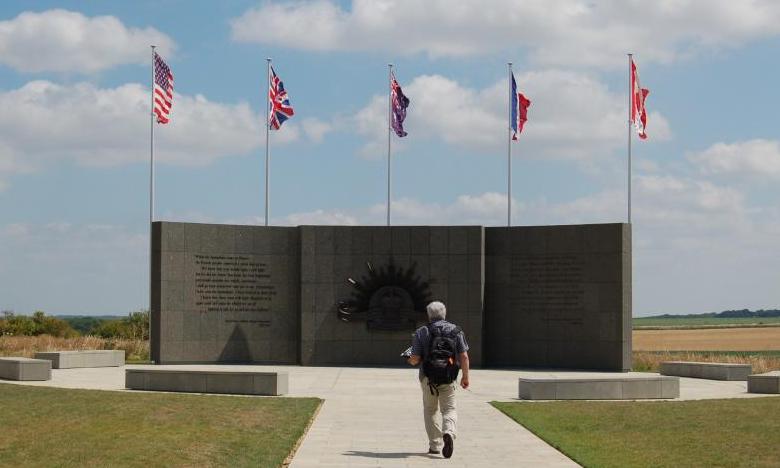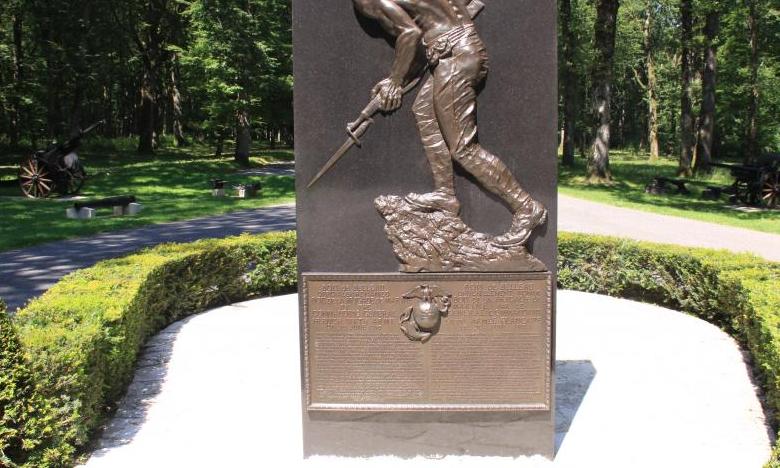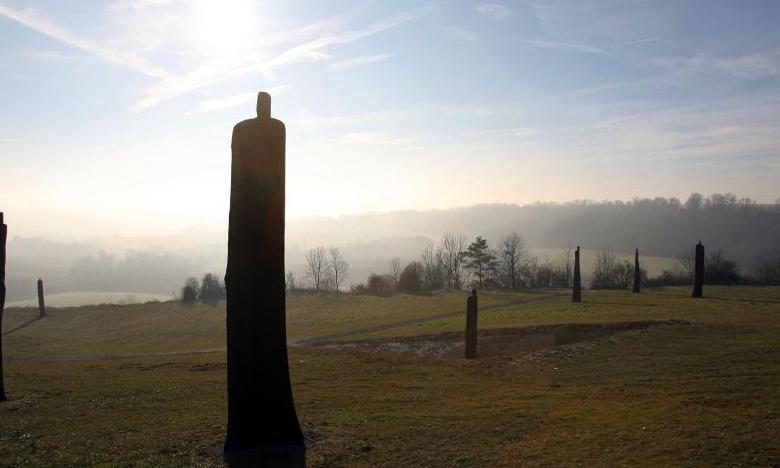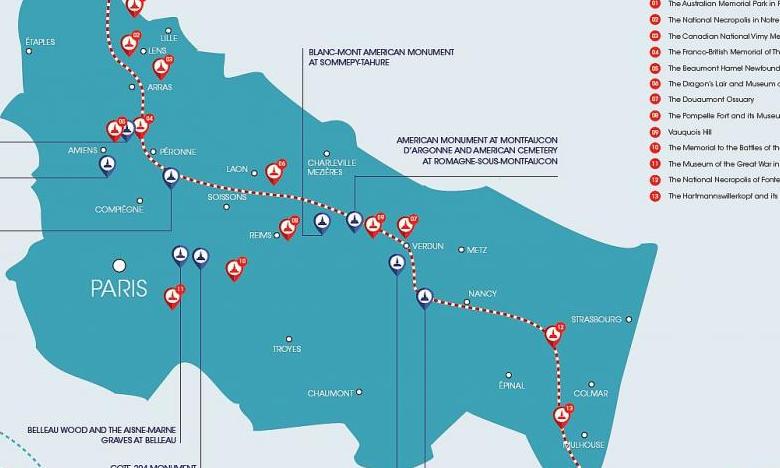MAJOR AMERICAN MEMORIAL SITES
1. Cantigny American Memorial Crédit photo: ©Somme Tourisme AL The Battle of Cantigny which took place between the 28th and 31th may 1918 was the first major American offensive of the Great War. The Americans suffered more than one thousand casualties during this battle, with 199 killed. A series of American successes began with the 1st Division at Cantigny. With nearly one million Americans in France during this period, the Allied moral rose, from being without hope they now imagined certain victory. Today, 1st American Division and 28th American Infantry Regiment Memorials at Cantigny testify to these feats of arms. ** 2. Le Hamel Memorial** Crédit photo: © Somme Tourisme AL The memorial commemorates the participation of the Australian and the American corps in the successful Battle of Le Hamel on the 4th July 1918 when General Monash lead his Australian and American troops into a tactical battle that lasted only 93 minutes. Twenty information panels give information about the Australian Corps and the Battle of Le Hamel, and remains of part of the captured German trench can also be seen.
3. Aisne Marne American Cemetery, wood and museum at Belleau Belleau is the emblematic village of the 4th Marine Brigade, which encountered terrible fighting in the wood in June 1918. Along a hiking trail, you will discover the remains of trenches, shell holes and ruins. A little farther on, the chapel and cemetery with 2289 war graves stand on a hill and pay tribute to the soldiers who fell in the vicinity of Château-Thierry in the summer of 1918. We then suggest that you descend into the village and stop at the Remembrance Museum of Belleau which explains the history of the French and American troops in the south of the Aisne. While you are here, ask the museum’s receptionist for the key to visit the Bulldog Fountain! Crédit photo : ©H_BALESSE
4. Oise-Aisne American Cemetery at Seringes-et-Nesles Crédit photo: © abmc
This beautiful cemetery, second largest of the World War I cemeteries in Europe, is set in the very place where the 42nd American Infantry Division, the “Rainbow Division”, fought. The grave of Joyce Kilmer, poet and famous author of Trees, can be found among the 6012 graves.
5. American Monument at Montfaucon d’Argonne and the American Cemetery at Romagne-sous-Montfaucon
Montfaucon d’Argonne
Crédit photo: ©Guillaume Ramon
American Cemetery at Romagne-sous-Montfaucon
Crédit photo: ©Guillaume Ramon
It consists of a massive granite column, which towers more than 200-feet above the war ruins of the former village. It commemorates the American victory during the Meuse-Argonne Offensive during the period September 26, 1918 to November 11, 1918, when the American First Army forced the German soldiers to conduct a general retreat on this front. On the walls of the foyer are an engraved map of the operations with a narrative and a special tribute to the American troops who served here. The observation platform on top of the memorial is reached by 234 steps and affords magnificent views of this battlefield. With its 14,246 headstones, the Romagne cemetery is the largest American cemetery in Europe, the final resting-place of American soldiers who fell in the fight to liberate the Meuse- Argonne area during WWI. Its layout and architecture make this a “must see”, to understand what Americans mean by their Duty of Remembrance. New Visitor Center opened in May 2016 at Meuse-Argonne American Cemetery explaining the role of the Americans and the critical importance of the Meuse-Argonne Offensive in WWI.
6. Château de Blérancourt Franco-American National Museum at Blérancourt - Anne Morgan Remembrance Crédit photo: ©F.X. Dessirier
In one wing of this château which once belonged to the Dukes of Gesvres, Anne Morgan, daughter of the banker J. Pierpont Morgan, set up in 1917 the headquarters of the humanitarian association devoted to helping the civilian population known as CARD (American Commission for Devastated Region). Anne Morgan stayed here until 1929 pursuing reconstruction work that still goes on to this day. She left Blérancourt after founding the National Museum of Franco-American Cooperation.
7. Montsec Memorial Crédit photo: ©Stephane Epis
The memorial was built by the United States of America on the top of a hill used by the Germans as an observation post. It commemorates the offensive by the 1st US Army in September 1918 and the battles fought until November 1918. A huge flight of steps leads up to the memorial consisting of columns topped by a rotunda. In the centre is a bronze relief map showing the various sectors of the offensive that wiped out the St-Mihiel Salient. The Monument offers a wonderful view on Madine Lake, the largest stretch of water of the region, at the heart of the Lorraine regional nature reserve.
8. Fort de Troyon - Saillant de Saint-Mihiel This Séré de Rivières fort was built entirely out of stone, with no concrete, and successfully held up against the heavy bombardment of September 1914 and the repeated attacks from the German army, saving Verdun from being surrounded, thereby protecting French rear-line troops who were fighting in the battle of the Marne. It served as rear basis, first aid and yard for American soldiers.
9. Blanc-Mont American Monument at Sommepy-Tahure The Sommepy Monument commemorates the achievements of the American units that served in combat with the French Fourth Army during the summer and fall of 1918. The tower of golden yellow limestone and its surrounding park are situated on Blanc Mont Ridge. The ridge has always been important to warring forces. German units occupying the site from autumn 1914 fortified it heavily. Vestiges of trenches remain in the area.
10. American Cemetery of Bony Somme American Cemetery at Bony@Colin
Pay your respects to the American soldiers in this beautifully laid out cemetery. It particularly pays homage to the soldiers who fought on the actual emplacement of the cemetery, from September 24, 1918, during the Battle of the Hindenburg Line. Today, among the roses bushes, 1844 soldiers lie at peace here and 333 are memorialized on the wall of the missing.
11. The Armistice Clearing Crédit photo: ©Jean-Pierre Gilson
“On 11 November 1918, at 5:15 in the morning, the armistice was signed.” 100 years later, the Armistice Clearing memorial site prepares for the centennial commemorations. A 500-m² extension, a newly designed and spacious scenography, and a new exhibition focusing on 10 key phases: from the WWI mobilization to the Second World War, via the interwar period. The museum’s famous Armistice Wagon will also benefit from a brand-new showcasing, immersing visitors alternately in the early morning hours and in the evening at dusk.
OTHER KEY REMEMBRANCE SITES
The Ring of Remembrance at Notre-Dame-de-Lorette Crédit photo: ©Jérôme Pouille
Standing alongside the French National War Cemetery at Notre-Dame-de-Lorette, this monument bears on the inside of its elliptical walls the names of almost the 580,000 soldiers killed in Northern France during WW1, in simple alphabetical order, without any reference to nationality, rank or religion. Perched on a plateau overlooking the village of Ablain-Saint-Nazaire, the memorial is an appeal to the citizens of today to remember the ravages of the Great War and to protect the fragile equilibrium of peace.
Guided visit to the Chemin des dames and Caverne du Dragon Former village of Craonne @ Farcy
From the very first clashes right to the end of the war, the Chemin des Dames was a frontline position where violent fighting took place, particularly during the Nivelle Offensive on April 16, 1917. Beneath the trench lines, more than 200 underground quarries were used to house the soldiers. Along a trail of 18.6 miles, many sites will enable you to discover and understand the history of this significant area of remembrance. Three places that cannot be missed are the Plateau de Californie, the former village of Craonne and the Caverne du Dragon, Museum of the Chemin des Dames. In this underground quarry called ‘The Caverne du Dragon’, which became army barracks during the Great War, you can follow along the many galleries in the footsteps of WW1 soldiers. The chapel, first aid station, command post and No Man’s Land movingly testify to the lives of these men - both French and German – who fought and lived, sometimes even side by side, in the obscurity of the cavern. More information : www.caverne-du-dragon.fr and www.chemindesdames.fr
Northern France
Vimy Visitor Education Centre
In 2017, Canada celebrated the 100th Anniversary of the Battle of Vimy Ridge, a seminal event in Canada’s history. The crowning achievement of the Centennial celebrations was the unveiling of state-of-the-art Vimy Visitor Education Centre ($5 million was committed by the Government of Canada in 2013) near the Canadian National Vimy Memorial in France – a project from Veterans Affairs Canada in partnership with the Vimy Foundation. While the Vimy monument itself is of course stunningly beautiful, currently visitors are given little context at the existing information booth as to why Canadians fought and died there; why Vimy remains special to the Canadian soul; and how Vimy, and other First World War battles at which Canadians fought, forever altered Canada’s status on the world stage. The Vimy Visitor Education Centre will answer these questions. Vimy Visitor Center
Visitor Education Centre at the Canadian National Vimy Memorial (Conceptual image courtesy of Robertson Martin Architect and Bisson+Castonguay)
Alsace
HARTMANNSWILLERKOPF - The National Monument
The Hartmannswillerkopf National Monument is one of the four national monuments to World War I in France. The facility consists of two entities: •an Altar of the Homeland that overlooks the esplanade and towers over the necropolis containing more than 1,256 graves of French soldiers and 6 ossuaries •a magnificent crypt, which is a genuine underground cathedral, accessed by an 80-meter-long trench-like alleyway.
The battlefield
The Hartmannswillerkopf massif is a pyramid-shaped rocky spur overlooking the southern part of the Alsace plain. From 1915, French soldiers in World War I nicknamed it „Vieil-Armand“ (Old Armand) and then described the cliff as a „Mangeur d’hommes” (man-eater) or the „Montagne de la Mort“ (Mountain of Death). Reaching its highest point at 956 meters, this strategic position was at stake during fierce fighting that took place between December 1914 and January 1916. The battlefield bears traces of the fights that killed 30,000 French and German soldiers. Fortified throughout World War I, many shelters and kilometres of trenches can still be seen today in a remarkable state of conservation. As such, the old battlefield is a genuine, open-air museum. Since 2014, it has been provided with a 4.5 km scenographic trail including 45 trilingual explanatory panels.
The franco-german historial of World War I
The Hartmannswillerkopf Franco-German Historial of World War I opened on Thursday, 3rd August 2017. Located in a state-owned area, it is a multi-faceted facility fulfilling a historical, touristic, memorial and, above all, educational role.
Beyond the local vision, the permanent exhibition constantly keeps sight of the duality and the Franco-German friendship, which began in the post-war period when fighters from both sides met again on the battlefields, even at international ceremonies. The historical discourse was established in collaboration with a scientific committee composed of specialists from both sides of the Rhine. The general presentation relies on human speech, which is enhanced by visual and audiovisual supports. All information is presented in 3 languages (French, German and English). Temporary exhibitions are also offered in a dedicated area.
Useful information: Open every day from May to mid-November. Guided tours on request.
Credit photo: ©Aerostatic
Meuse
The renaissance of Verdun Memorial - Verdun
The Museum has been refurbished and expanded. Built on the battlefield site, the extensive collection is housed in 1,600m2 of permanent exhibition space, helping visitors to understand the battle and the hellish conditions endured by soldiers. www.memorialdeverdun.fr
Verdun Memorial Crédit Photo : ®B. Jamot





